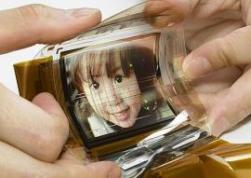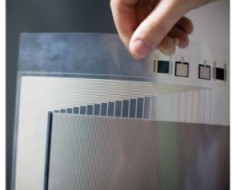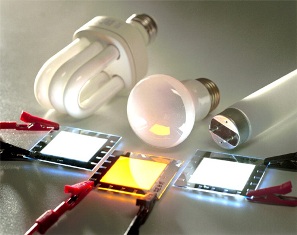Categories: Featured Articles » Interesting electrical news
Number of views: 28666
Comments on the article: 3
New technologies. Conductive plastic
 The article talks about the upcoming breakthrough in the field of electronics - these are conductive plastics. The TV can be rolled up. The era of flexible electronics is about to begin.
The article talks about the upcoming breakthrough in the field of electronics - these are conductive plastics. The TV can be rolled up. The era of flexible electronics is about to begin.
Until now, the main role in modern electronics is played by materials such as copper (wires and other conductive parts) or silicon (semiconductors, computer "chips"). We present plastics more in the form of instrument housings, insulating coatings. Material scientists think differently, they believe that in the near future organic materials based on carbon can become the main raw material in the production of radioelements, magnets, lasers.
The possibilities of plastics are endless, if you synthesize millions of molecules, replacing individual sections in them, you can create polymers with many functions. For example, dissolve such polymers in a chemical solvent, use them as ink for a printer, and print any electronic circuit. This is a huge advantage over previously used materials, both economic and technological. And this means that very soon plastic or organic electronics will enter everyday reality.
More recently, the Japanese company again pleased us: a new generation television appeared on sale. Its main material is conductive plastic. Plastic displays are thin and easy to bend, their thickness is 1 mm or less. Ideally, such a screen can even be rolled up or glued to the walls in the form of wallpaper with a video image. The price is biting so far, but experts claim that such displays will be in the public domain in a few years. With good color rendering and low power consumption, they are ahead of both LCD monitors and plasma displays.
 Ohio State University first made magnets from organic material. In New Jersey, telephone companies were able to develop a new plastic-based electric laser. If you create a low-temperature regime for this material, it acquires the properties of a superconductor.
Ohio State University first made magnets from organic material. In New Jersey, telephone companies were able to develop a new plastic-based electric laser. If you create a low-temperature regime for this material, it acquires the properties of a superconductor.
The South Korean company Samsung has embarked on the path of creating flexible integrated circuits. This is the beginning of a long way to create high-grade microcircuits, since the question is how to form organic and inorganic transistors on the same substrate.
In the near future, the reader will be able to create a newspaper with his own hands. One has only to connect a sheet of paper to a cell phone or computer and download information from the Internet.
Organic LEDs - this is the basis of revolutionary technology, these are thin-film materials obtained from organic compounds. If a current is passed through them, they will emit light. In the last century, electronics was based on silicon semiconductors; in the 21st century, it will be based on plastics and other organic compounds.
In 2000, the Nobel Prize was awarded to scientists who chose a new course in the development of electronics, who managed to turn plastic, consisting of molecules connected into long polymer chains that do not conduct electricity, into an electrical conductor. The volume of the plastic electronics market is $ 3 billion; the forecast for 2015 is $ 30 billion.
As usual, the Japanese and Koreans became the innovators of the technology introduction, but Russian scientists also work in this direction. Leading researcher Sergei Ponomarenko (Institute of Synthetic Polymer Materials of the Russian Academy of Sciences), together with colleagues from Europe, developed a “smart” substance. From it then received an organic thin-film transistor. FROM.Ponomarenko says: "The layer thickness of this substance is one molecule, it is able to self-assemble into the thinnest layer and has the properties of a semiconductor." This development is very important, because the amount of materials spent, and therefore the cost of the electronic device, is reduced.
 Flexible screens and video wallpapers, these are not all the achievements of the new technology, it can be implemented in many areas of life. If the chips are printed on paper, then, for example, packaging of goods can be done electronically. At a distance of several meters, the system counts and displays on the screen the information necessary for the buyer: about the cost, expiration date, manufacturer.
Flexible screens and video wallpapers, these are not all the achievements of the new technology, it can be implemented in many areas of life. If the chips are printed on paper, then, for example, packaging of goods can be done electronically. At a distance of several meters, the system counts and displays on the screen the information necessary for the buyer: about the cost, expiration date, manufacturer.
You can save a lot if you even make the bulbs plastic, because they will be cheap and less energy-intensive. In the warehouse, it will be possible to print an electronic circuit on a box or box instead of computer codes, which can receive a radio signal and send a response. After the requesting signal, the receiving device will be able to record the response from each box and print a table with the contents of each warehouse.
As a result, plastics can crowd out traditional materials from computer technology, since the path to miniaturization in increasing the speed of computer circuits will be exhausted.
The plastic technological revolution is approaching, in the meantime, some problems must be solved. Organics interact with oxygen, moisture, so you need to find a material that protects plastic electronics from damage and increases its life. After the successful completion of research on this topic, we can talk about the advent of the era of flexible electronics.
See also at bgv.electricianexp.com
:

